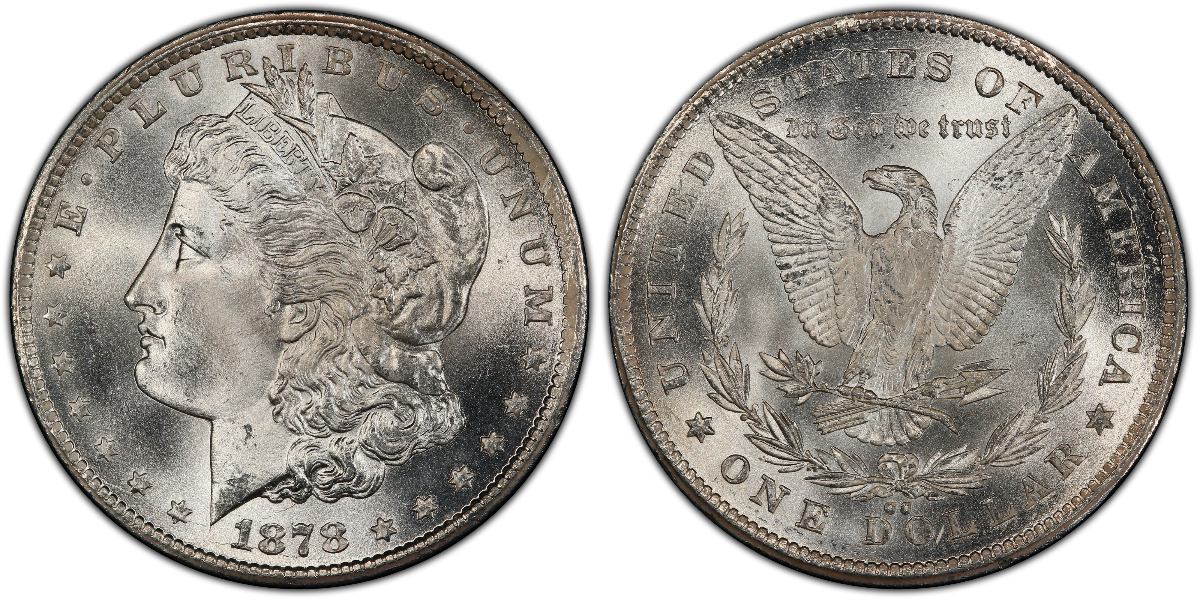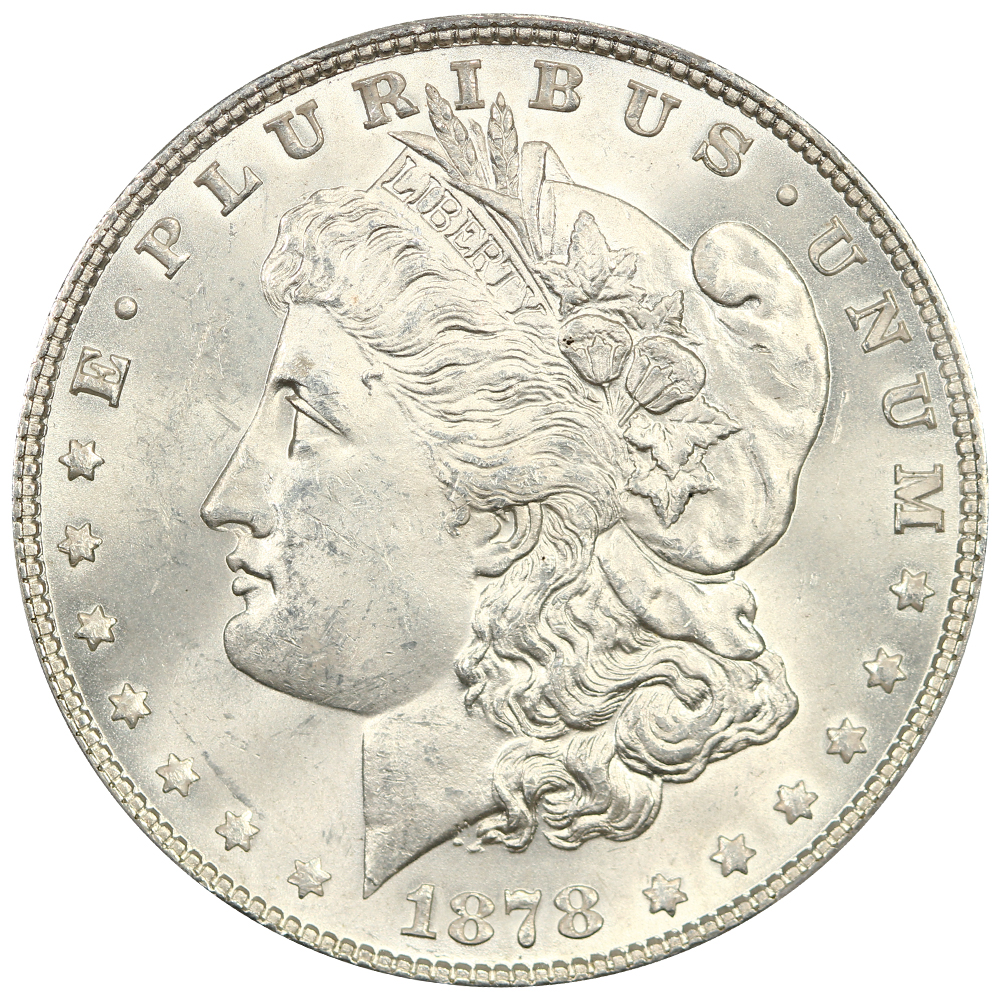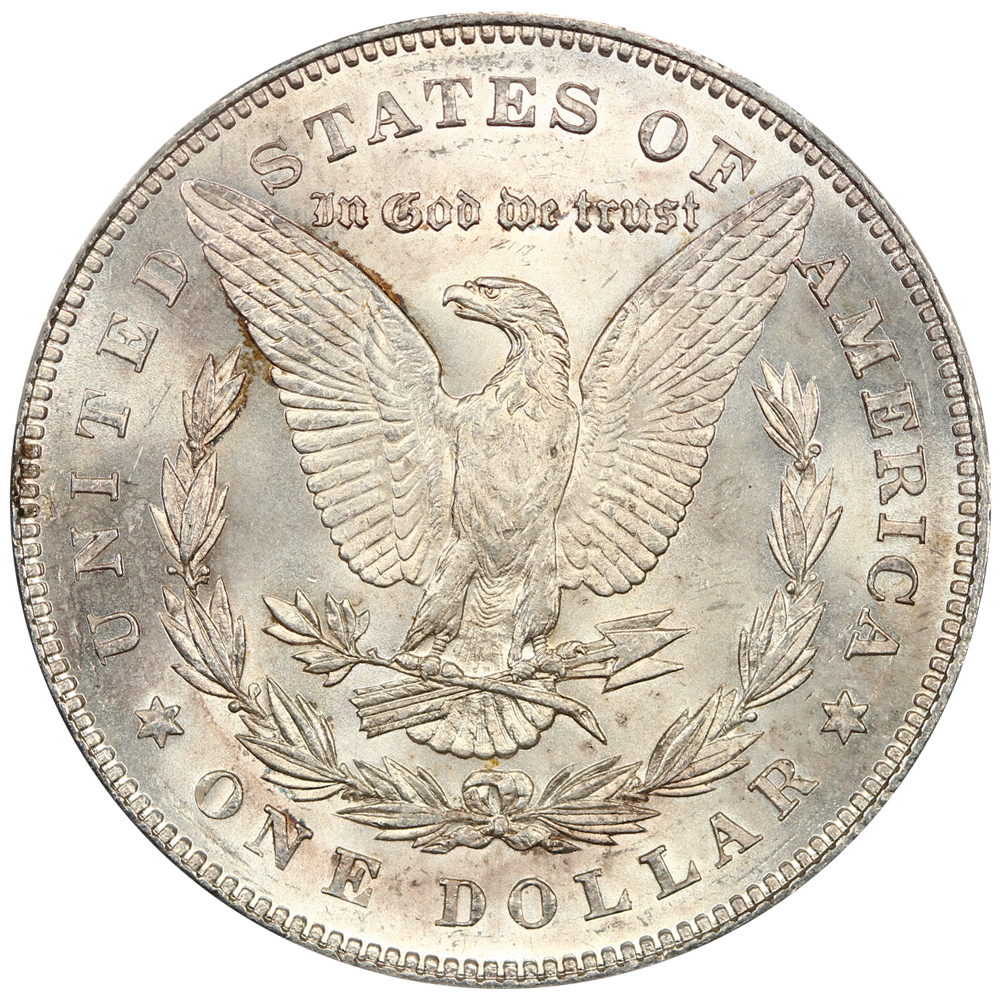
Coin Snapshot
- Weight: 26.73 Grams
- Composition: 90% silver, 10% copper
- Diameter: 38.10 mm
- Thickness: 2.40 mm
- Years Minted: 1878-1904, 1921
- Designed by: George T. Morgan
Designed by US Mint engraver George T. Morgan, the Morgan Silver Dollar was first introduced to the American people in 1878. The artistry on both the obverse and reverse of the coin are considered by many collectors to be one of the most beautiful designs ever featured on a circulating US coin. When the coin was initially released in 1878, it was well-received by the public and was consequently minted for 26 years (1878 – 1904). Though no coins were minted after 1904, the Morgan Dollar underwent one final issue in 1921 to compliment the release of the new Peace Silver Dollar.
During its time in circulation, over 600,000,000 coins were minted overall, which means that there are still plenty of Morgan Dollars available today for collectors to enjoy. In fact, the Morgan Silver Dollar is among one of the most popular US Coins to collect – both within the United States and abroad. Though a complete set of Morgan Dollars includes well over 90 coins and can be very costly, many collectors choose build smaller sets based on dates, mints and varieties. No matter how you decide to collect Morgans, finding the right coins for your collection is usually not too difficult.
Morgan Dollar Coin Design
The Morgan Dollar can trace its origins back to 1876, when the US Mint Director of the time (Henry Linderman) sought to redesign all of the country’s silver coins. Linderman began the process by contacting fellow Mint Director of the Royal Mint in London for help. He asked C.W. Fremantle (Royal Mint Director) to find him a “first class die-sinker” who would be interested in becoming the Assistant Engraver at the Philadelphia branch of the United States Mint.
Fremantle ended up responding by recommending George Morgan, who in 1876 was just 30 years old. By that time in his life, Morgan had built up a stellar reputation within the engraving world in London but there were no suitable job openings for him within the country. Soon thereafter, Morgan and Linderman worked out an agreement for Morgan to work at the Philadelphia branch of the US Mint underneath Chief Engraver of the time, William Barber. After a 6-month trial period it ended up working out, as Morgan would go on to design the most popular US Silver Dollar that the United States has ever put into circulation.
During its first year of issue (1878), the Morgan Dollar underwent several minor design changes to its reverse. The first batch of coins minted in 1878 featured 8 tailfeathers on the eagle (reverse side). The design was later updated to show only 7 tailfeathers. This resulted in three different varieties of Philadelphia minted 1878 Morgan Dollars; the 7 tailfeather, 8 tailfeather and the 7/8 tailfeather varieties (7 over 8 tailfeathers). Though the coin underwent these minor design updates, it has stood the test of time and remains atop the list of the most popular coins in the world to collect. In fact, because there are three different varieties struck during the first year of issue makes them even more appealing to coin collectors.
Obverse Design

The obverse of the Morgan Dollar features George Morgan’s depiction of Lady Liberty at its center. The bust of Lady Liberty that is seen on the Morgan Dollar was actually based off of an actual woman named Anna Willess Williams. A majority of the United States’ previous coinage featured depictions of Lady Liberty that were inspired by Greek figures or mythical beings. However, Morgan wanted to create a design that featured more of an American style, so he chose Mrs. Williams (a Philadelphia native).
Lady Liberty is shown on the front of the coin, facing left and wearing a crown that bears the word “Liberty”. On each coin, the year is stamped onto the center of the coin just below Morgan’s depiction of Lady Liberty. Above her, the Latin phrase “E Pluribus Unum” is stamped. She is surrounded by a total of 13 stars, with 7 stars on the left and 6 on the right, which represents the original 13 colonies of the United States.
Reverse Design

The reverse of the Morgan Dollar is much more complex than the obverse. At the center on the reverse of each coin, an eagle is the focal point and the main design feature. Morgan’s depiction of the eagle is extremely intricate, and its feathers can be seen in full detail. The bird is holding a bundle of arrows in its left talon, while its right talon clutches a single olive branch.
Directly above the eagle, the phrase “In God We Trust” is stamped. Surrounding the eagle is the name of the country (United States of America) as well as the denomination of the coin (One Dollar). All coins struck at a mint other than Philadelphia will contain a mintmark (S, O, CC, D) while coins struck at Philadelphia will not have any markings here. The mintmark is always located at the center of the coin directly underneath the wreath.
Mint Locations and Mintmarks on the Morgan Dollar
During its time in circulation, the Morgan Dollar was struck at a variety of US Mint locations. In fact, it was the last silver dollar variety to be struck in both Carson City, NV and New Orleans, LA. With that said, coins were not necessarily struck at each different mint for each year that the coin was minted. For example, there were no coins minted in Denver except during 1921 and no coins were struck at Carson City after 1893. Depending on the year, Morgans can be found with the following mintmarks:
– No mintmark (Philadelphia, PA – all years)
– S mintmark (San Francisco, CA – all years)
– O mintmark (New Orleans, LA – all years)
– D mintmark (Denver, CO – 1921)
– CC mintmark (Carson City, NV – 1878-1885, 1889-1893)
Morgan Dollar Mintage Chart (Business Strike)
Read our chart below to see how many business strike coins were minted during each year of circulation.
| Year | Philadelphia | New Orleans | San Francisco | Carson City | Denver |
|---|---|---|---|---|---|
| 1878 | 10,508,800 | 0 | 9,774,000 | 2,212,000 | 0 |
| 1879 | 14,806,000 | 2,887,000 | 9,110,000 | 756,000 | 0 |
| 1880 | 12,600,000 | 5,305,000 | 8,900,000 | 495,000 | 0 |
| 1881 | 9,163,000 | 5,708,000 | 12,760,000 | 296,000 | 0 |
| 1882 | 11,100,000 | 6,090,000 | 9,250,000 | 1,133,000 | 0 |
| 1883 | 12,290,000 | 8,725,000 | 6,250,000 | 1,204,000 | 0 |
| 1884 | 14,070,000 | 9,730,000 | 3,200,000 | 1,136,000 | 0 |
| 1885 | 17,787,000 | 9,185,000 | 1,497,000 | 228,000 | 0 |
| 1886 | 19,963,000 | 10,710,000 | 750,000 | 0 | 0 |
| 1887 | 20,290,000 | 11,550,000 | 1,771,000 | 0 | 0 |
| 1888 | 19,183,000 | 12,150,000 | 657,000 | 0 | 0 |
| 1889 | 21,726,000 | 11,875,000 | 700,000 | 350,000 | 0 |
| 1890 | 16,802,000 | 10,701,100 | 8,230,373 | 2,309,041 | 0 |
| 1891 | 8,693,556 | 7,954,529 | 5,296,000 | 1,618,000 | 0 |
| 1892 | 1,036,000 | 2,744,000 | 1,200,000 | 1,352,000 | 0 |
| 1893 | 378,000 | 300,000 | 100,000 | 677,000 | 0 |
| 1894 | 110,000 | 1,723,000 | 1,260,000 | 0 | 0 |
| 1895 | 880 (proof only) | 450,000 | 400,000 | 0 | 0 |
| 1896 | 9,976,000 | 4,900,000 | 5,000,000 | 0 | 0 |
| 1897 | 2,822,000 | 4,004,000 | 5,825,000 | 0 | 0 |
| 1898 | 5,884,000 | 4,400,000 | 4,102,000 | 0 | 0 |
| 1899 | 330,000 | 12,290,000 | 2,562,000 | 0 | 0 |
| 1900 | 8,830,000 | 12,590,000 | 3,540,000 | 0 | 0 |
| 1901 | 6,962,000 | 13,320,000 | 2,284,000 | 0 | 0 |
| 1902 | 7,994,000 | 8,636,000 | 1,530,000 | 0 | 0 |
| 1903 | 4,652,000 | 4,450,000 | 1,241,000 | 0 | 0 |
| 1904 | 2,788,000 | 3,720,000 | 2,304,000 | 0 | 0 |
| 1921 | 44,690,000 | 0 | 21,695,000 | 0 | 20,345,000 |
| 2021 | 175,000 (no mark) 175,000 (O privy) 175,000 (CC privy) | 0 | 175,000 | 0 | 175,000 |
| Total | 305,971,347 | 186,097,629 | 131,363,373 | 13,766,041 | 20,520,000 |
History of the Morgan Silver Dollar
Prior to the introduction of the Morgan Dollar in 1878, the Seated Liberty Dollar was the last standardized dollar coin issued by the United States Government. It was struck from 1840 up to 1873 when congress passed the Coinage Act of 1873 – which, among other things, ended the minting of the Seated Liberty Dollar – officially placed the nation on the Gold Standard. The Acts also removed the right of private citizens who owned silver bullion to have their metal struck into fully legal tender dollar coins.
After the Seated Liberty Dollar, the Trade Dollar was issued between 1873 and 1878, however, it was primarily intended to be used for international commerce with China. Because it was not intended for domestic, private trade, the Trade Dollar is technically not a “silver dollar” since it was not backed by the faith of the United States Government nor was it intended to be used by US citizens.
Beginning in 1876, the Director of the US Mint started on a mission to design new silver coins for the United States. Along the way, he contacted the Deputy Master of the Royal Mint in London for help. The Deputy Master referred a man named George T. Morgan for the job, as there were no openings for him within the Royal Mint system at that time. No one knew it at the time, but Morgan would go on to become one of the most notable designers in US history.
Morgan Silver Dollar Prices
Even though each Morgan Dollar contains less than one troy ounce of pure silver, their prices generally fetch much more than melt value and can vary tremendously. The price of any given Morgan Silver Dollar can be determined by several factors such as; condition, rarity, mintage, population and grade or certification. For example, a coin that has a low mintage (based on the year of issue and the minting location) that is also in a high Mint State grade and is certified by a top grading company (such as NGC or PCGS) can fetch thousands – or hundreds of thousands – of dollars!
Today, collectors can find high mintage, circulated examples of Morgan Dollars for less than $50 USD. While – on the other hand – extremely scarce, low mintage years and special varieties can fetch well over $50,000 USD!
Examples of Rare and Expensive Morgan Dollar Coins
There are many rare varieties and low mintage years of the Morgan Dollar. Below is a list with the most expensive and sought after Morgan Dollar varieties.
1895 Proof Morgan Dollar
In 1895, there were no Morgan Dollars struck at the Philadelphia Mint. However, a mere 880 proof coins were struck there. This means that in order for a collector to acquire a Philadelphia minted coin from 1895, they would need to purchase a proof variety. As you can imagine, there are well over 880 Morgan Dollar collectors, so the law of supply and demand can drive prices for one of these coins through the roof. It is not uncommon to see an 1895 Proof Morgan Dollar in high mint state grade to reach six figures in auction!
1893-S Morgan Dollar
This coin has the lowest mintage out of all business strike Morgan Dollars in the entire series! Exactly 100,000 coins were struck in 1893 at the San Francisco branch of the United States Mint, making them extremely scarce. The survival estimate, according to PCGS is a mere 9,948 coins! On average, the US Mint typically struck over 10,000,000 Morgan Silver Dollars per year – however, in 1893, less than 1.5 million were struck overall, with the San Francisco mint releasing the lowest number of coins.
Finding an 1893-S Morgan Dollar in a high Mint State grade will set you back well over $200,000! Even a low quality example in G6 condition will run around $4,000. Due to the high price range, it is not unheard of to find a real 1893 Morgan Dollar minted in Philadelphia (no mintmark) to have been fraudulently stamped with an “S” mintmark in order to increase the value. For this reason, it is very important that you purchase a certified coin that has been authenticated by a reputable company such as NGC or PCGS.
Morgan Dollar Condition and Certification
Since the Morgan Dollar was struck well over 100 years ago, they are usually tough to find in high Mint State condition. Generally, most of the coins that still exist today have been circulated (since that was their intended purpose when they were released by the United States Government in 1878). For this reason, if a Morgan Dollar is Almost Uncirculated or in Mint State condition they are much more desirable.
The two largest and most reputable companies when it comes to authenticating and grading rare coins are NGC and PCGS. For this reason, both collectors and investors tend to gravitate towards coins that have been certified by one of these two companies. This means that coins certified by NGC and PCGS are more desirable compared to coins that have been certified by lesser known grading companies.
